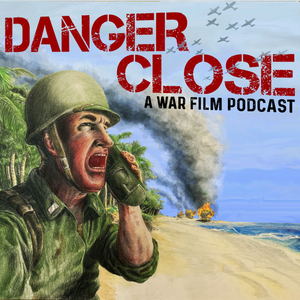Research for Danger Close: The Battle of Long Tan
Micah Neidorfler
B.A. in History, Minor in German Language
Infantry Captain in the US Army
Graduate of the Command and General Staff College’s distance learning
“Army Field/Unit Historian Course”
A Doctrinal Paradigm: The Battle of Long Tan
History is replete with examples of units utilizing doctrine to good effect. American military
circles are quite familiar with the Battle of 73 Easting, the Assault on Brecourt Manor and
the Battle of Ia Drang. While it is natural for the American military to focus on their own
past successes, it is important to view history in breadth, so as not to miss sterling
examples set by other militaries. In that vein the Battle of Long Tan, fought between
the Australian army and the Viet Cong (VC) serves as an exemplary lens through which
modern military practitioners can analyze current doctrine. In the battle of Long Tan,
D Company, 6 Battalion, Royal Australian Regiment under the command of
MAJ Harry Smith defeated a regimental-sized North Vietnamese force on 18 August 1966.
They accomplished this by adhering to the fundamentals of a Movement to
Contact (namely: make initial contact with small, mobile, self-contained forces to avoid
decisive engagement; and keeping subordinate forces within supporting distances to
facilitate a flexible response), as well as using the concept of Echelonment of Fires.
As South Vietnam’s armed conflict with North Vietnam began escalating in the
early 1960s, the United States perceived the struggle in terms of communist expansion
into Southeast Asia and began committing military forces to assist the South
Vietnamese government. Australia, already accustomed to anti-communist military
intervention from the Malayan Emergency (1948-1960) 1 , and seeking to remain a
relevant ally, joined America by sending a small number of military advisors to South
1 Paul Ham, Vietnam: The Australian War (Sydney: Harper Collins, 2007), 88
Vietnam in 1962. 2 The Australians brought with them extensive jungle-fighting
experience from their time in Malaya and the 2 nd World War. The Australians increased
their advising commitment to approximately 300 personnel by the end of 1964. By late
1965 they added an infantry battalion to their expeditionary force. 3 This battalion was
attached to the US 173 rd Airborne Brigade, where it became clear that the Australians
and Americans had opposing views on how the war should be fought at the tactical
level. The Australians focused military efforts on counterinsurgency while the Americans
focused on large scale search and destroy operations. 4 As a result of this dichotomy
and Australia’s political desire to share a significant load of the war effort, the US gave
Australia its own area of responsibility: the Phuoc Tuy province on South Vietnam’s
southern coast (See Appendix 1).
To fulfill this obligation Australia established the 1 st Australian Task Force (1ATF)
in April 1966. 5 Throughout its existence 1ATF was usually comprised of three infantry
battalions, one artillery regiment with one attached New Zealand 105mm battery and
one attached American 155mm battery, two engineer squadrons, one Armored
Personnel Carrier (APC) squadron, one Tank squadron, one logistics company, and
one reconnaissance flight. Also consistently attached to 1ATF were three New Zealand
infantry companies and one troop of the New Zealand Special Air Service. 6
1ATF’s primary mission was to maintain control over Phuoc Tuy and support US
formations in neighboring provinces if necessary. The main enemy in Phuoc Tuy was
VC guerrillas. The VC were an organized guerrilla force commanded and supported by
2 Ibid., 91
3 Larsen and Collins, Vietnam Studies: Allied Participation in Vietnam
(Washington D.C., Department of the Army, 2005), 88-89
4 Ham, Vietnam (2007)., 109
5 Ian McNeill, To Long Tan: The Australian Army and the Vietnam War 1950-1966
(St Leonards, Allen & Unwin Pty Ltd, 1993), 231
6 Larsen and Collins, Vietnam Studies (2005), 95
the North Vietnamese Army (NVA). They conducted insurgent attacks and small-scale
conventional operations in South Vietnam while the NVA fought near the border and the
central highlands. To this end 1ATF’s leadership established their main base of
operations on the rubber plantation of Nui Dat and their logistics center at Vung Tau (See
Appendix 2). 1ATF chose Nui Dat for its central location to the province’s main population. 7
Key to Australian counter-guerilla doctrine, Nui Dat’s location allowed the Australians to
spread influence in urban centers and isolate the VC from the population.
After establishing Nui Dat Camp in June 1966, 1ATF began conducting
operations throughout Phuoc Tuy to interdict VC infiltration and find and destroy VC
troop concentrations. At that time 1ATF’s infantry complement was only two Infantry
Battalions: 5 th and 6 th Battalions Royal Australian Regiment (5RAR and 6RAR). Due to
Nui Dat’s size and because 1ATF’s logistics footprint was located separately, one
battalion would conduct operations while the other conducted base security, continued
improving base defenses, and rested. 8
On 16 August 5RAR was patrolling to the north of Nui Dat near the town of Binh
Ba and 6RAR was conducting priorities of work around Nui Dat. At 0243 on the morning
of the 17 th , Nui Dat came under mortar fire. 1ATF sound-triangulated the mortars and
fired counter-battery missions. The attack lasted until 0305 and wounded 23 soldiers,
one of whom later died. 9 The 1ATF commander Brigadier Oliver Jackson, ordered a
patrol from 6RAR to reconnoiter the suspected point of origin (POO) site of the mortar
attack. The 6RAR commander, Colonel Colin Townsend ordered B CO 6RAR to
7 McNeill, To Long Tan (1993), 121
8 James Eling, interview with Dave Sabben, The Principles of War Podcast:
Episode 26 https://theprinciplesofwar.com/podcast/26-
long-tan-4-the-terrain-in-phuoc-tuy-and-the-base-at-nui-dat/
9 Lex McAulay, The Battle of Long Tan (Hawthorn, Hutchinson of Australia, 1987), 28-32
conduct this patrol, which left C and D CO 6RAR as the only infantry formations on Nui
Dat (as A CO 6RAR was out on local patrols to the north). 1ATF signals intelligence
(SIGINT) suspected two VC Regiments and one VC Battalion to be in the area and
Jackson, concerned with the possibility of an organized VC attack, ordered 5RAR and
A/6RAR to return to Nui Dat. 10 Unfortunately, 1ATF HQ did not inform its subordinate
units of the suspected regiment-sized VC elements. The radio locating methods used by
the SIGINT section were classified, consequently 1ATF HQ did not disseminate any
intelligence gained thereby to subordinate units. The battle of Long Tan would prove the
flaws in this reasoning and 1ATF HQ would rescind the policy shortly afterwards. 11
B/6RAR spent the 17 th patrolling east of Nui Dat, towards the hills at Nui Dat 2
and the Long Tan rubber plantation, where the POO site was templated (See Appendix 3). The
majority of B CO was scheduled to rotate out of theater on rest and recuperation leave
on the 18 th , so Townsend ordered D/6RAR to patrol out and replace B CO on the
morning of the 18 th . Major Harry Smith commanded D CO and his company consisted of
a mixture of regulars and national service conscripts, yet had gained the reputation of
being the fittest, most professional company in the Battalion by the time of their
deployment. 12
On the morning of the 18 th , D CO patrolled east from Nui Dat and linked-in with B
CO on the western edge of the Long Tan plantation. The B CO commander informed
Smith that they had discovered the baseplate locations of the VC mortars, bloody
bandages, and several recently used trails leading to the northeast. Smith ordered D
10 Ibid., 33-38
11 James Eling, The Principles of War Podcast: Episode 25.
https://theprinciplesofwar.com/podcast/25-long-tan-3-to-vung-tau/
12 Ibid.
CO to follow trails northeast. 13 D CO moved in a traveling overwatch company wedge,
platoon wedge with 11 Platoon under 2LT Gordon Sharp in the lead position, 10 Platoon
under 2LT Geoff Kendall to the rear left, and 12 Platoon under 2LT David Sabben to the
rear right. Each platoon kept 100 meters spacing between each other. Smith centered
his HQ element between the three platoons. 14 A few hundred meters further down the
path D CO encountered miscellaneous mortar equipment and more blood-soaked
bandages scattered on the ground. Smith reported this to Townsend and continued
east, moving closer to the rubber-tree grove. Now anticipating enemy contact as more
likely but still wanting to maintain speed, he adjusted D CO’s formation into a traveling
company vee, platoon wedge with 10 Platoon front left, 11 Platoon front right, 12
Platoon to the rear, and company HQ between the three platoons, while keeping 100
meters between each platoon. 15
A few minutes later 11 Platoon’s lead section reached a dirt road (See Appendix 4). At
1540 D CO began crossing and two sections of 11 Platoon were across when the
platoon HQ element spotted six VC walking unaware along the road to 11 Platoon’s
right. 11 Platoon HQ engaged the VC who fled to the southeast. Smith ordered 11
Platoon to clear a few hundred meters in that direction and 11 Platoon discovered one
dead VC and an AK47. D CO reported to 6RAR that the VC were dressed in Khaki
uniforms and carried automatic weapons. This was unusual, as the VC in Phouc Tuy
normally wore black and used bolt action rifles or semi-automatic carbines.
13 Terry Burstall, The Soldier’s Story: The Battle at Xa Long Tan Vietnam, 19 August 1966
(St. Lucia, University of Queensland Press, 1986), 46-49
14 Ibid., 51
15 Bob Grandin. The Battle of Long Tan: As Told by the Commanders
(Crows Nest: Allen & Unwin, 2004), 117-118
Unfortunately, 1ATF’s SIGNINT policy meant 6RAR was not aware of large enemy
elements in the area, so the significance was lost, and D CO continued to the east. 16
Because of the crossing drill, 10 Platoon (on 11 Platoon’s left) lagged 50 to 100
meters behind 11 Platoon. Suddenly, at 1610 11 Platoon came under machine gun fire
to their left front (See Appendix 5). Several 11 Platoon soldiers from 6 Section were killed
outright, and the platoon took cover and returned fire only to be engaged by a second
machine gun to their front. Sharp ordered his unengaged 5 Section to move around the
right and flank the VC, but as they got up to move, they took heavy small arms and
RPG fire from their front right, which killed and wounded several more of Sharp’s men.
11 Platoon was pinned and Sharp apprised Smith over the radio that he faced at least a
platoon-sized VC force and requested artillery. Adding to the stress, a monsoon rain
began just minutes after the first machinegun opened fire which limited visibility to 50
meters and turned the ground to mud. 17
At company HQ, New Zealand Army fire support officer Captain Morrie Stanley
began calling fire missions based off Sharp’s reported location. Stanley could not see
11 Platoon’s position because of the rubber trees and monsoon, so he initially called the
artillery far beyond Sharp and began halving the distance to walk the rounds onto
target. 18 At the same time, Sharp reported that the VC had begun launching assaults on
his platoon, supported by yet more machine guns. Smith realized that they faced a force
much larger than a platoon and likely larger than a company. He told Stanley to request
16 Burstall, The Soldiers’ Story (1986), 51
17 Ibid., 53-55
18 McAulay (1987), 51
a second battery to support, but Nui Dat rebuffed Stanley’s request, forcing Smith to
radio 1ATF himself to demand the extra support, which was finally granted. 19
It was clear that 11 Platoon would be unable to extract itself, so Smith ordered 10
Platoon to move up to 11 Platoon’s flank and provide support for 11 to withdraw (See
Appendix 6). Geoff Kendall moved his platoon forward but suddenly ran into an entire VC
platoon which was moving around 11 Platoon’s left flank. 10 Platoon engaged this
formation, which withdrew. However, 10 Platoon took three casualties and became
heavily engaged by more machineguns and small arms from their left, which destroyed
their radio. Around this time in 11 Platoon, Sharp was killed, and his platoon sergeant
Bob Buick took command. Unable to communicate with the company and taking heavy
fire from their left, Kendall ordered his platoon to stop and take cover. A few minutes
later a runner from company HQ arrived with a replacement radio. After speaking with
Kendall, Smith reluctantly ordered 10 Platoon to return to HQ’s position. 20
At this time D CO also began receiving poorly observed mortar fire. Based on the
reports from Kendall and the fact that they were receiving indirect fire, Smith knew he
was facing a substantial enemy and he had Stanley request the support of the 155mm
howitzers at Nui Dat. This time Stanley received no push-back and the 155s began
firing counter-battery missions. After silencing the enemy mortars, the 155s began
directly supporting D CO. Stanley now managed four batteries: three 105s and one 155.
Stanley utilized the 105 batteries to provide support as close to the platoons as he could
and used the 155 battery to interdict the VC deeper back. 21
19 Eling, Episode 34.
https://theprinciplesofwar.com/podcast/34-how-was-artillery-controlled-at-long-tan/
20 McAulay, (1987), 40-46
21 Eling, Episode 34.
Around 1700 Smith requested emergency resupply and a relief force. He was
told that an APC-mounted infantry company would be dispatched soon. Shortly after,
Smith ordered his rear 12 Platoon to push around the Company’s right flank and
attempt to extricate 11 Platoon. Around this same time three US F-4 Phantom jets
arrived to conduct a napalm drop, but due to the heavy rain they were unable to identify
the colored smoke the Australians used to mark their positions. Smith requested the jets
to drop their ordinance closer to the hill of Nui Dat 2 where he suspected the enemy’s
main body was located, so to still achieve affects but not risk fratricide. 22
At 1715 Sabben led 12 Platoon southeast towards the gunfire (See Appendix 7). They
soon took fire from their own right flank, indicating that the VC were quickly surrounding
the entire company. 12 Platoon continued and after moving about 250 meters they
encountered a VC platoon between them and 11. Sabben’s platoon engaged and
scattered the VC, but quickly came under attack from two more platoons trying to work
their way between 11 and 12 Platoon. Around 1800, unable to continue moving forward,
12 Platoon went to ground and Sabben threw yellow smoke as far forward as he could,
hoping the surviving 11 Platoon soldiers would see it and move towards them. 23 At the
same time Buick requested Stanley to call 105mm fire on his position. Stanley refused,
to which Buick replied that 11 Platoon was about to be overrun. Stanley replied that he
would do as Buick asked, but carefully edged the target closer to 11 Platoon without
bringing the rounds all the way in. This fire mission caused the VC to pause long
enough for 11 Platoon to see Sabben’s smoke, and they hastily pulled back, taking
more casualties as they did. 24 Then the two platoons made their way back to company
22 McAulay, (1987), 53-54
23 Eling, Episode 28.
https://theprinciplesofwar.com/podcast/28-long-tan-6-the-transition-to-the-defence/
HQ. At about the same time, two Australian Huey helicopters arrived near D CO’s HQ
with an ammunition resupply. D CO HQ marked their position with red smoke and the
crews pushed the ammunition boxes out of the Hueys. 25
Smith set the company into a perimeter defense once 11 and 12 Platoons
returned to company HQ (See Appendix 8). By 1820 the perimeter was set. With 10 and 12
Platoons down to 75% strength, 11 platoon almost combat ineffective, their resupplied
ammunition dwindling once again, and darkness approaching, the situation looked
dire. 26 For the next forty minutes D CO fended-off multiple company-sized assaults with
the help of Stanley’s fire missions and suffered four more killed. During this time, a relief
force consisting of a platoon of APCs and A/6RAR made their way closer to D CO’s
position, destroying multiple platoon-sized VC formations. The arrival of the relief force
around 1900 broke the VC’s will to fight and they withdrew under cover of the fading
light. 27
The combined forces of 6RAR now in the field withdrew about 800 meters to
another location and established a new perimeter where they spent the night. Over the
next three days 6RAR, supported by 5RAR conducted a clearance operation through
the battlefield. They recovered the bodies of their dead, discovered two surviving 11
Platoon soldiers, and collected and buried the bodies of the VC. In the end, D CO
suffered 18 KIA and 24 WIA, a stiff price for a company. The VC casualties, however,
were far greater: 245 KIA and an estimated 350 WIA. 28 For the remainder of Australia’s
24 Ibid.
25 Burstall, The Soldiers’ Story (1986), 84-88
26 Ibid., 194
27 Ibid., 110-121
28 Eling, Episode 28. https://theprinciplesofwar.com/podcast/36-why-was-long-tan-a-victory/
military commitment in Vietnam, VC forces never massed the amount of combat power
in Phouc Tuy province that they had at Long Tan.
With such a lopsided force ratio it is hard to believe that D/6RAR not only
survived, but also inflicted such massive casualties on their enemy. While tenacity and
personal courage surely contributed to their success, their practice of good tactics was
vital. Although the battle occurred in 1966 and D/6RAR was not an American unit,
Australian Army doctrine in the 1960s closely resembled NATO doctrine. Therefore, it is
appropriate to analyze D CO’s actions through modern US Army doctrine.
The Battle of Long Tan occurred as D CO was patrolling to locate the VC force
that had mortared Nui Dat the day prior. Consequently, D CO’s patrol can be viewed as
a modern Movement to Contact (MTC): “A commander conducts a movement to contact
when the tactical situation is not clear, or when the enemy has broken contact.” 29 As a
MTC is conducted when the tactical situation is unclear, it is inherently risky since the
friendly unit does not know where the enemy is or what their strength is. Consequently,
ATP 2.21.10 contains six fundamentals that help mitigate the risks inherent to a MTC.
D/6RAR adhered to all these fundamentals, but two were primarily import. First, D CO
made “initial contact with [a] small, mobile, self-contained force to avoid decisive
engagement of the main body on ground chosen by the enemy.” 30 This fundamental
means that a unit conducting a MTC should not mass its forces closely together since
this would allow the enemy to decisively engage all elements of the unit. Smith task-
organized his company with the intent of finding the VC and protecting his formation.
During initial stages of D CO’s MTC they moved in a traveling-overwatch company
29 Department of the Army Headquarters, ATP 3-21.10 Infantry Rifle Company
(HQDA: Washington DC, 2018), 2-61
30 Ibid., 2-62
wedge with one platoon forward and two platoons to the rear, with each platoon
organized into a platoon wedge. After discovering hard evidence of VC presence Smith
changed his formation to traveling overwatch with two platoons up front and one in the
rear but maintained spacing between the two platoons to the front, and with each
platoon still in a platoon wedge. These formations ensured that the company’s frontage
was composed of smaller units which could control themselves and allow their echelon
leadership to react: each platoon could respond to its subordinate sections making
contact, and the company to respond to its subordinate platoons making contact. Smith
increased the risk of multiple elements making contact simultaneously when he
changed the formation to two platoons up front, however, doing so better facilitated
following the VC blood trails (adhering to another fundamental of a MTC: Focus all
efforts on finding the enemy). 31 Smith mitigated this increased risk by maintaining
spacing between platoons, which prevented the VC from identifying both platoons at the
same time. These formation choices bore out when 11 Platoon’s 6 Section became
pinned down and Sharp was able to maneuver his 5 Section. Even when the entirety of
11 Platoon became decisively engaged, no other element in the company was in
contact with the enemy, which allowed Smith to pursue multiple methods of response.
The second primary MTC fundamental D/6RAR followed was: Keep subordinate
forces within supporting distances to facilitate a flexible response. 32 This means that all
subordinate units of the overall MTC need to be close enough that they can move to
support each other if necessary. Smith’s company movement formations have already
been discussed, but it is important to point out that many commanders would have been
31 Ibid., 2-62
32 Ibid., 2-62
daunted at the idea of moving in a company wedge (and especially a company vee)
through jungle/rubber plantation conditions. 33 Many would have chosen a company
column to increase ease of control. 34 This would have increased the distance and
response time between D CO’s subordinate platoons. The wedge and vee formations
also keep most company elements in appropriate supporting locations: on each other’s
flanks, instead of directly behind each other as in a column. As it happened, Smith’s
choice of company wedge and later company vee allowed each platoon to rapidly
support each other post-contact. This was demonstrated when 11 Platoon became
decisively engaged and Smith was able to quickly maneuver both 10 and 12 Platoons to
respond, which ultimately enabled 11 Platoon to withdraw and the company itself to
form a defensive position, proving the usefulness of this fundamental.
Finally, D/6RAR relied on indirect fire support to level the odds in their favor.
Stanley and Smith directed the support of three 105mm batteries, one 155mm battery,
and one sortie of 3 F4 Phantoms. With this much support it would have been easy for
Stanley and Smith to commit fratricide by calling for fire on a subordinate platoon. The
concept of echelonment of fires helped Stanley and Smith effectively orchestrate this
mass of support. Echelonment of fires means using indirect fire support with the largest
blast radius as close to friendly units in contact with the enemy as possible to maximize
effects on the enemy, then working fire support with smaller blast radiuses even closer
to friendly units. This ensures that there is always indirect fire on the enemy even as the
distance between friendly and enemy closes. 35 At the beginning of the battle, D CO
utilized a single battery of 105mm guns to support 11 Platoon. As the battle progressed
33 The Wavell Room, Tea, Toast and Tactics Podcast: Company Command.
https://wavellroom.com/podcast/company-command-
tea-toast-and-tactics-with-ash/
34 Ibid., 2-11 – 2-12
35 Ibid., D-34
and more 105mm batteries became available, each platoon received a battery in direct
support. The platoons, through Stanley, used these as close to their own positions as
possible. When the 155mm battery was made available, Stanley used it to fire further
into the enemy’s formation, which created a deeper area of effect and kept the 155s
greater danger area away from D CO. This allowed the 105s to focus on destroying VC
close to D CO while the 155s destroyed VC further back and disrupted the command
and control of the entire VC formation. 36 When the F4 Phantoms arrived, Smith knew
their munitions would have an even greater effect than the 155s. The monsoon
prevented them accurately locating D CO, so he requested that they drop their
munitions further forward to the northeast where the preponderance of VC attacks
originated from. This allowed the effects to be delivered but mitigated the risk of
fratricide. If D CO had not echeloned their supporting fires, there would have been
significant casualties from fratricide and the effects on the VC would not have been as
great.
The Battle of Long Tan is a story of a small, professional force defeating a far
numerically superior enemy. Vastly outnumbered, D/6RAR relied on their training and
indirect fire support from their headquarters to survive. By utilizing their own tactics,
techniques, and procedures which mirror 21 st century US doctrine, D CO not only
survived, but dealt such a significant blow to the VC in Phouc Tuy province that they
never massed as much combat power against the Australian Army again.
36 Eling, Episode 34.
Appendices
Appendix 1
South Vietnam
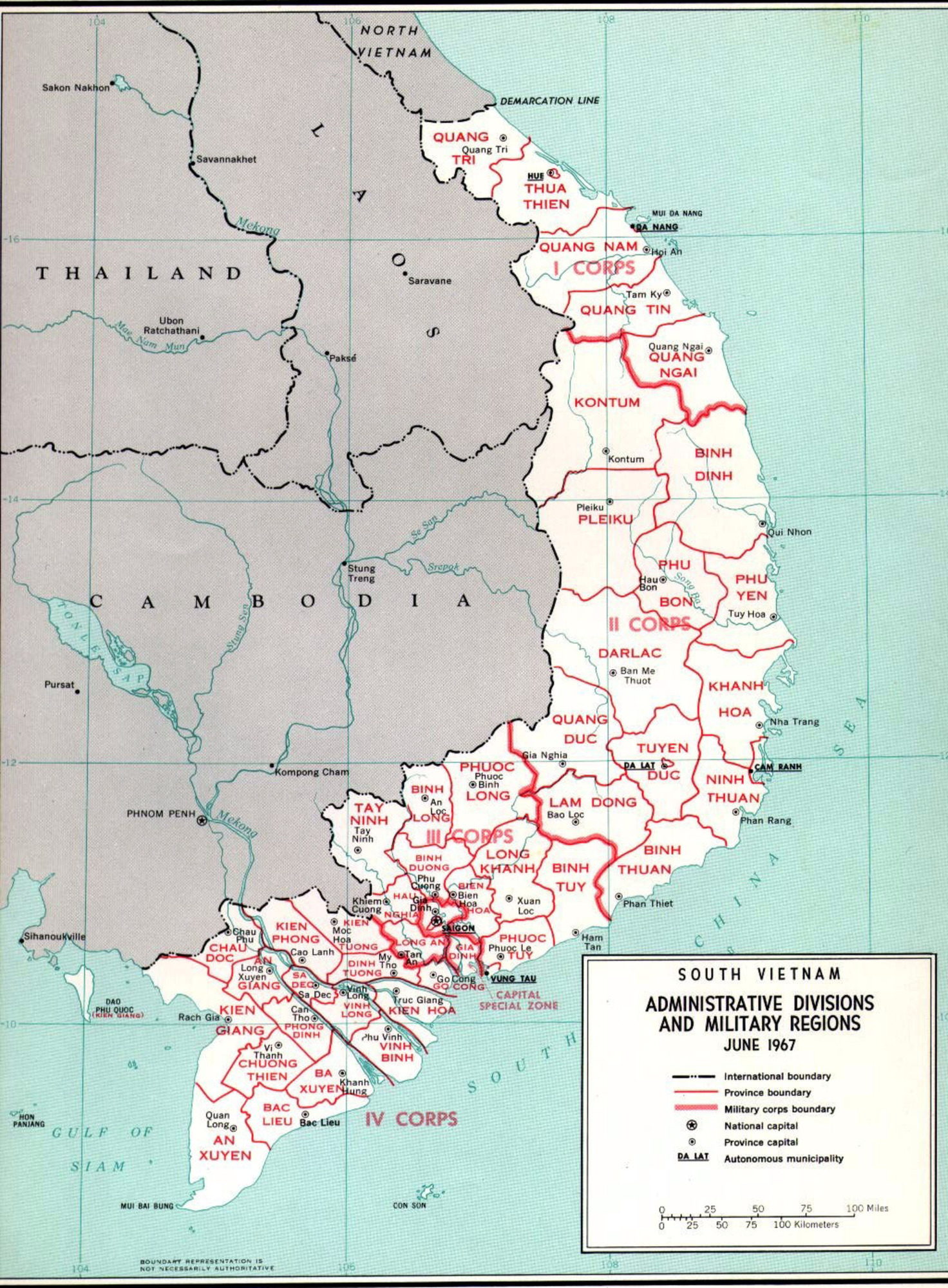
Appendix 2
Phuoc Tuy Province
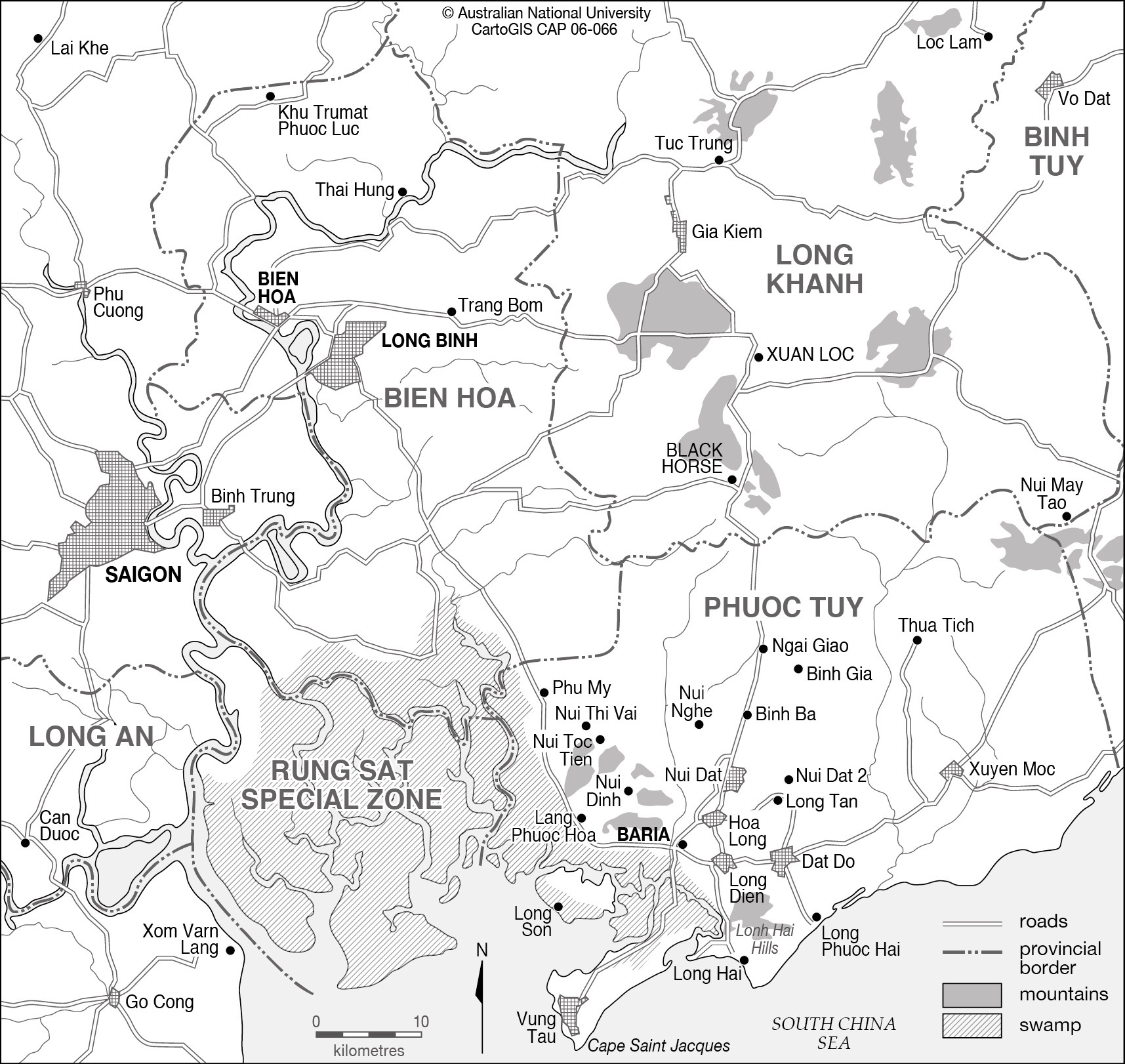
Appendix 3
Map VC Baseplate Locations & Withdrawal Routes

Appendix 4
Map of D/6RAR at 1540
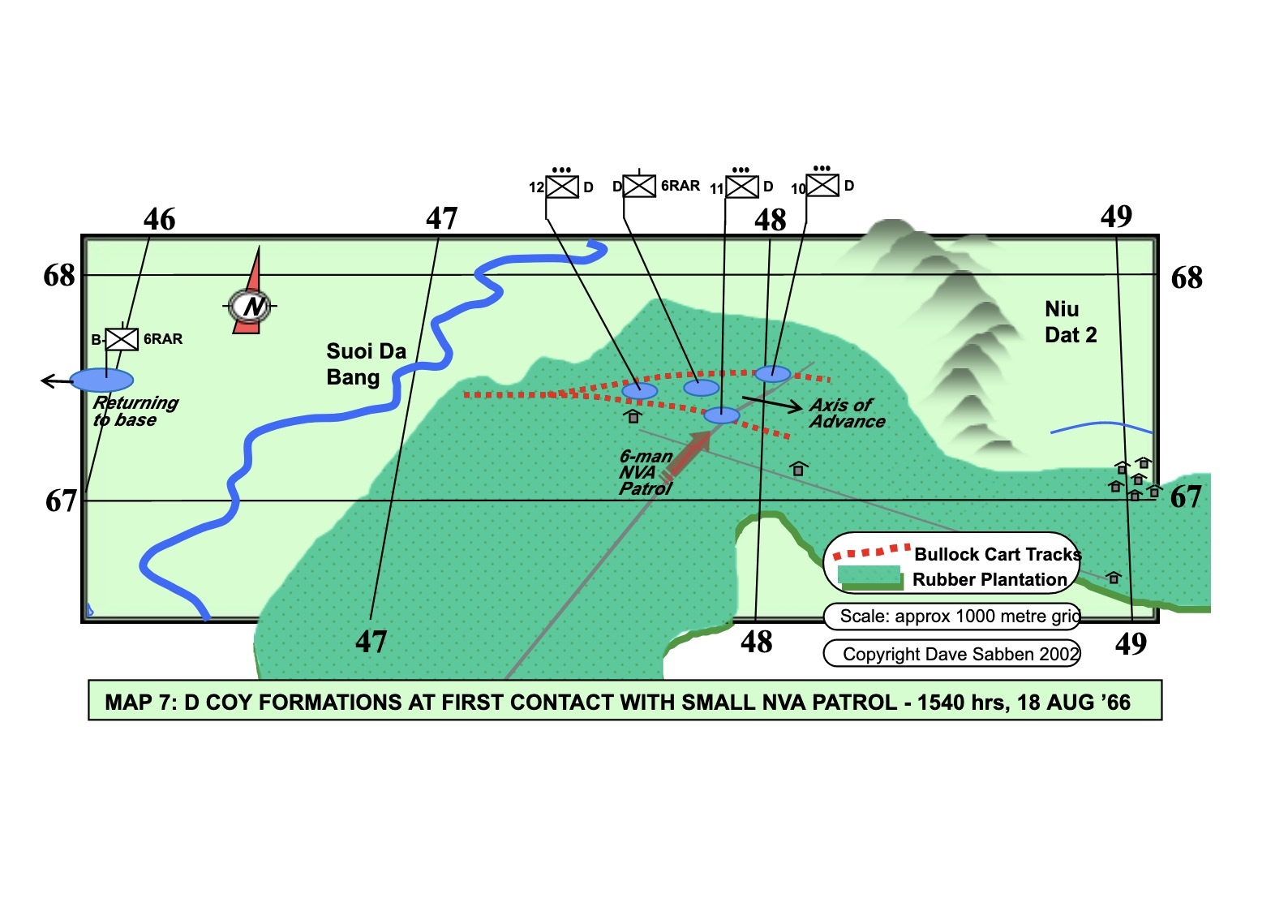
Appendix 5
Map of D/6RAR at 1600-1630
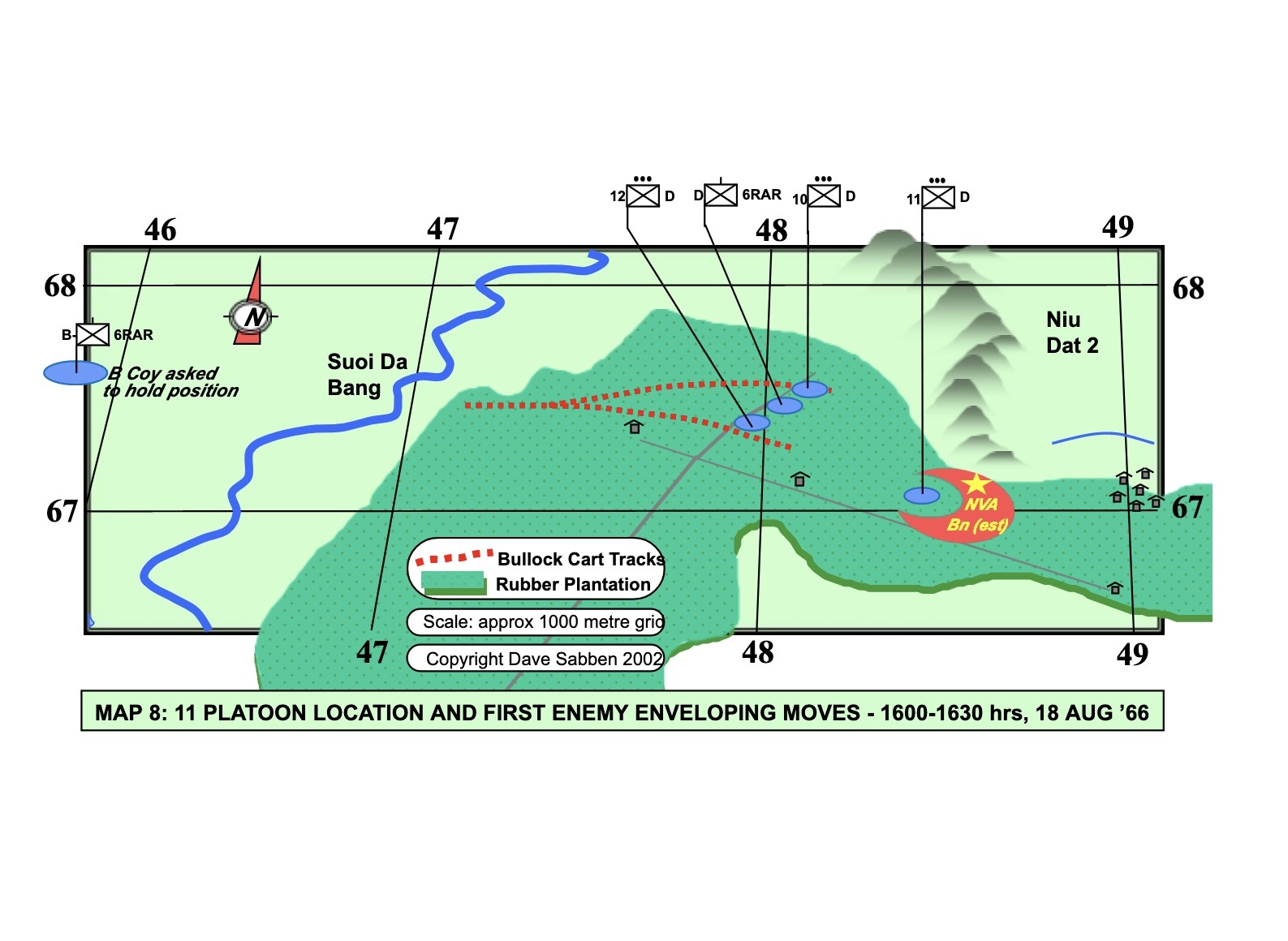
Appendix 6
Map of D/6RAR at 1630-1700
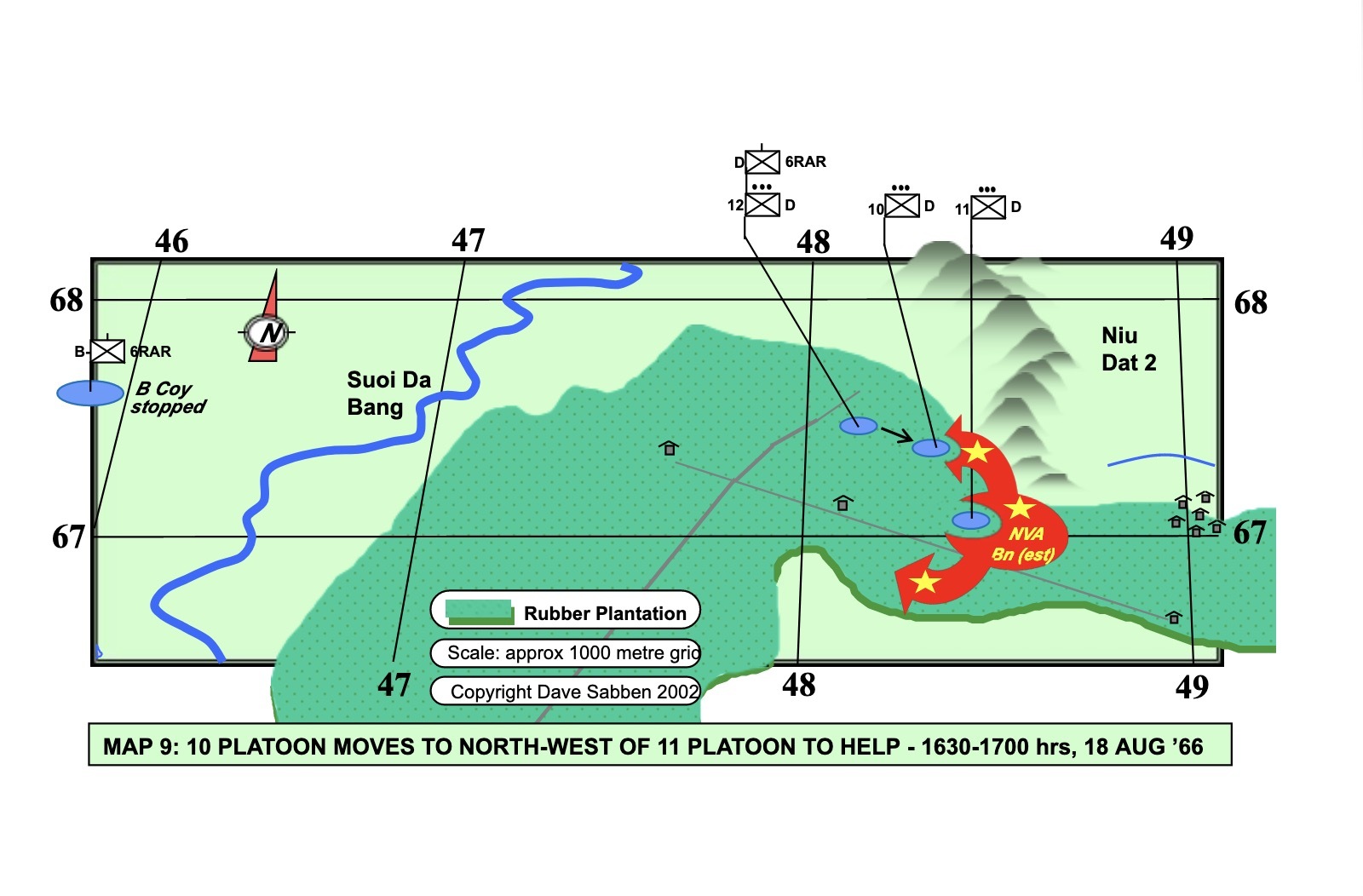
Appendix 7
Map of D/6RAR at 1700-1800
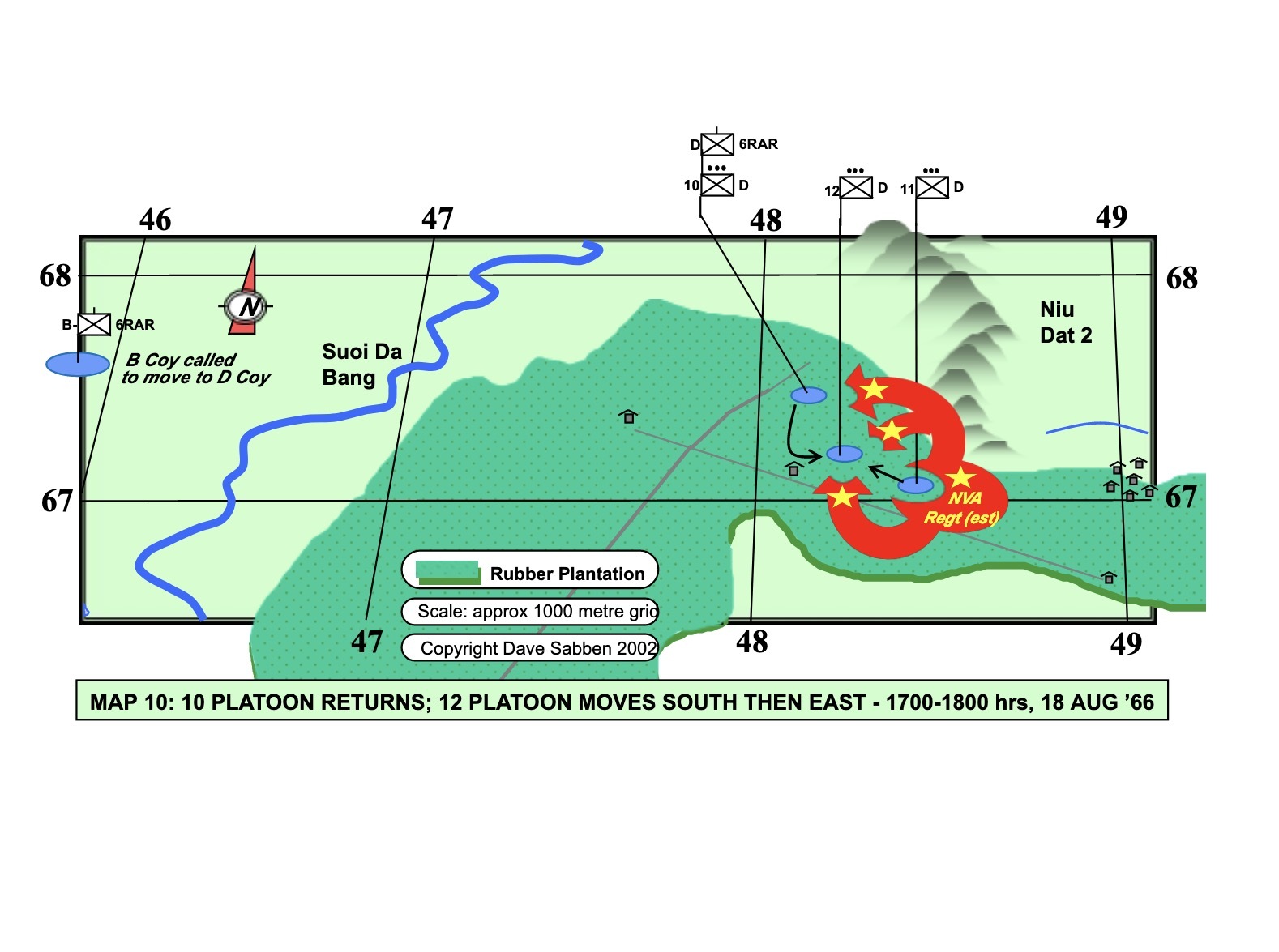
Appendix 8
Map of D/6RAR in Final Stage of Battle
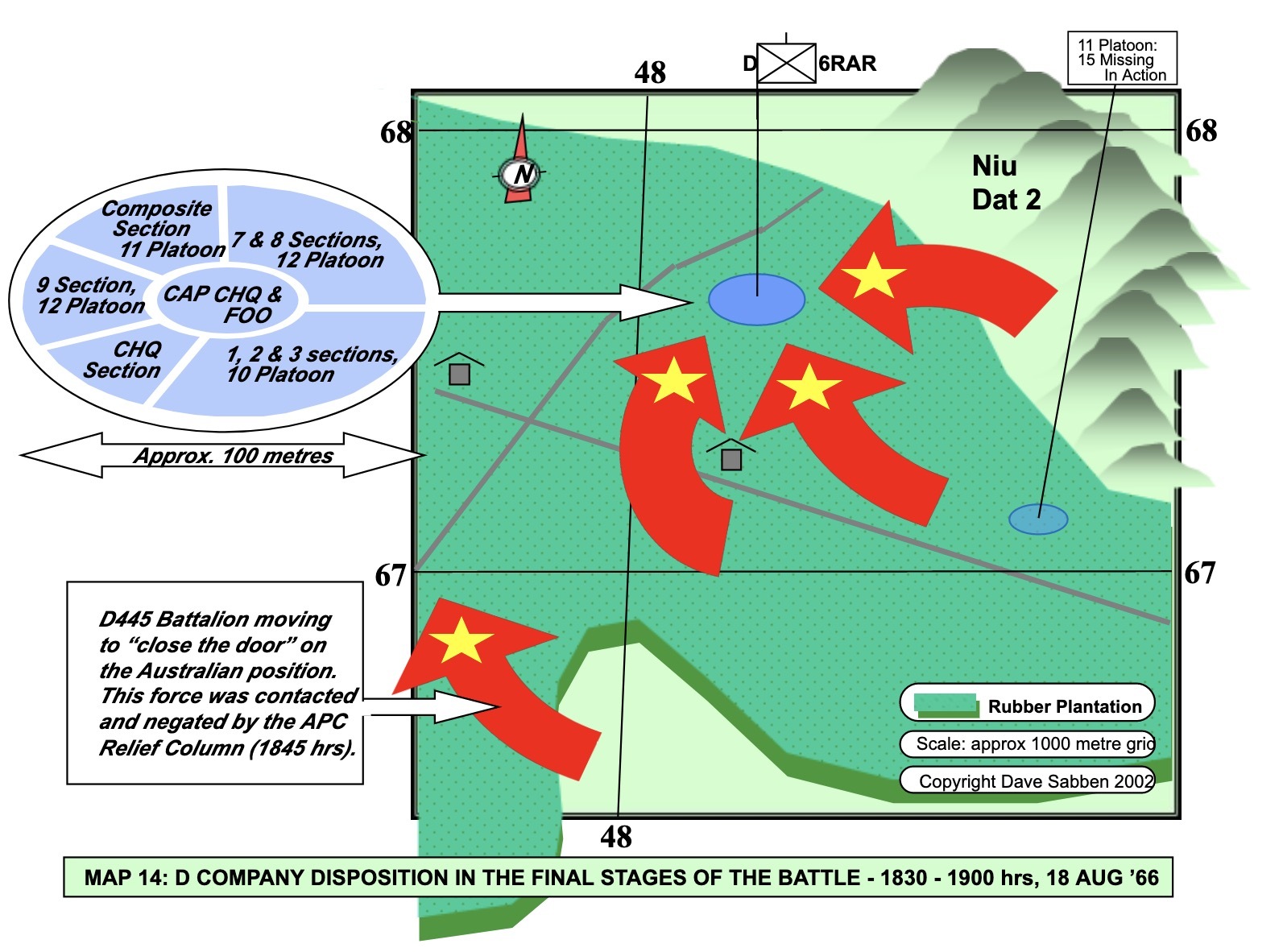
Bibliography
Burstall, Terry. The Soldiers’ Story: The Battle at Xa Long Tan Vietnam, 19 August 1966.
St. Lucia: University of Queensland Press, 1986.
Eling, James. Interviews with Dave Sabben and Harry Smith, The Principles of War
Podcast, Podcast Audio, multiple episodes: 23-28, 31, 34-37, 40, 55-58.
https://theprinciplesofwar.com/
Grandin, Bob. The Battle of Long Tan: As Told by the Commanders. Crows Nest: Allen
& Unwin, 2004
Ham, Paul. Vietnam: The Australian War. Sydney: Harper Collins, 2007.
Larsen, Stanley and Collins Jr., James. Vietnam Studies: Allied Participation in Vietnam.
Washington D.C.: Department of the Army, 2005.
McAulay, Lex. The Battle of Long Tan. Hawthorn: Hutchinson of Australia, 1987.
McNeill, Ian. To Long Tan: The Australian Army and the Vietnam War 1950-1966. St.
Leonards: Allen & Unwin Pty Ltd, 1993.
The Wavell Room. Tea, Toast and Tactics Podcast: Company Command.
https://wavellroom.com/podcast/company-command-tea-toast-and-tactics-with-ash/
Appendices Bibliography
Appendices 1 & 2: Australian National University Website:
https://asiapacific.anu.edu.au/mapsonline/
Appendices 3-8: Images made digitally by Dave Sabben in 2002. Found within Bob
Grandin’s book The Battle of Long Tan: As Told by the Commanders. Crows Nest: Allen
& Unwin, 2004
Film Breakdown:
Bottom Line Up Front: IF YOU WANT TO KNOW ANYTHING REAL ABOUT THE BATTLE OF LONG TAN, DO
NOT REFER TO THIS MOVIE. IT IS HORRIBLY HISTORICALLY INNACURATE.
05:25 (Soldier asks if it’s incoming fire or outgoing fire) What a stupid question. The rounds are
impacting in the base, of course it’s incoming. This dialogue was clearly written to put some military
sounding buzzwords in the film.
05:33 (Smith tells the radio operator to tell the PLs to hurry up) This is where the film starts to get its
portrayal of MAJ Harry Smith wrong (in my opinion). From what I’ve read, he wasn’t a yelly “beat people
over the head” type of person. He wouldn’t have spoken to his radio operator that way. He was
professional, and so were his platoon leaders. They were very well trained, they had worked together
for a long time prior to coming to Vietnam, and this whole exchange would not have happened. No PL
needs 3 minutes to give compass bearings to where they hear the mortar tubes being fired from, so they
would never have said they needed 3 minutes to begin with.
5:51 (LT Gordon Sharp is playing poker) This scene is so contrived. While it is true that Sharp was likely
the most easy going and least military of the platoon leaders in D CO, he wasn’t an idiot who would have
continued playing cards after receiving artillery. Smith himself states that he trusted all of his platoon
leaders and that they were professional. He does say Sharp was the weakest of the three, but still says
he was competent and a good leader. Also, the whole discussion of the rounds being incoming is so
stupid, the rounds have already began impacting in the camp, everyone knows they’re incoming.
6:30 (same scene) I just want to say again I really really hate this scene. There is zero mention of Sharp
behaving in this way in the 5 books I have read about Long Tan or in any of the interviews I have listened
to. Sharp is said to have played cards with his soldiers and to have been perhaps a little to buddy-buddy
with them, but no evidence that he behaved this way under fire.
8:07 (PVT Large drinking a beer in his fighting position) Again, a likely completely made-up scene. 6RAR
had been in country for a few months at this point, they had conducted multiple combat patrols, had
been in multiple fire fights (albeit small ones). I don’t think any of them were stupid enough to act in this
manner. But if everyone was serious and professional, I guess that would make for a dull movie.
8:16 (LT Dave Sabben arrives with his mortar triangulation report) This far into the film its clear that the
writers of the screenplay and the director clearly don’t know how people in the military act. Why would
Sabben go to attention during combat? Also, its clear the writers and directors don’t know how Harry
Smith acted as a person, there is no evidence that he was verbally abusive to his subordinates. He held
them to high standards, but I do not believe the treated them the way he does in the film. The film Harry
Smith is an asshole for no reason.
8:21 (Smith yells at Stanley) Again, a totally misguided scene. The film really rags on CPT Morrie Stanley,
the New Zealand artillery officer serving as D CO’s company fire support officer. The film makes him
seem timid, unconfident, and slightly incompetent. This is totally made up for the film. In reality Stanley
was incredibly competent and did not suffer from confidence issues. Smith personally praised Stanley
very highly after the battle. Also, he is right in this scene, as D CO is located at the base, their
triangulation reports should be sent to the BN fire support cell, who will be receiving triangulation
reports from the other units on Long Tan, so their triangulation will be more accurate than if D CO did it
themselves, as Smith is saying in this scene. So Smith (in this scene) is wrong, it is the job of the higher
level artillery section to process the fire mission, not Stanley’s.
09:25 (negligent discharge) In the 5 books I’ve read about Long Tan, none of them mentioned Large
accidentally firing his weapon. This is totally made up for the film.
11:10 (Smith makes flippant remark) Yeah, again, the persona of Harry Smith in this film is completely
made up by the writers and director. He wasn’t a pompous ass who would say shit like that.
14:24 (Smith physically assault Large) Once again, completely fake scene. Large didn’t accidentally fire
his weapon in real life. But even if he had, Smith would not have handled this this way. It’s totally
unprofessional. People outside the military may think that holding someone up against a tent pole by
their shirt collar shows you’re a big person and in charge, but if an officer did this to a soldier: A, it’s
unprofessional, and Smith was a very professional person in real life. B, it makes you no longer an
authority figure, it now just makes you a bully who can’t get what he wants unless he resorts to physical
coercement. That’s not how you get subordinates to respect you. And threatening to kill one of your
soldiers sure as hell isn’t going to get that person to want to follow you. The whole “relationship” that
develops between Large and Smith is completely fiction.
14:21 (Company Sergeant Major Kirby tries to talk to Smith) UGH, this whole “Harry Smith is arrogant”
thing is 100% made up for the film. Smith had been with the Company way before they went to
Vietnam. He didn’t treat them this way. Yes, he trained them hard and enforced discipline, but he wasn’t
an asshole, and he did respect them. He sure as hell didn’t ignore his company sergeant major (same
position as a company First Sergeant in the US Army). If a company commander blatantly ignores this
senior enlisted advisor, he’s a bad officer. The film tries to make this seem like Smith is just being hard
because he want’s them to survive. But everything the Film-Smith does is wrong. Straight up wrong. And
he didn’t even act this way in real life. It’s totally fictional.
18:52 (Smith complains to the 1 ATF commander Townsend) Again, 100% made up. Smith had been with
his company way before Vietnam. He knew his men, and he had trained them to standard. He did not
feel this way about his company. It’s made up, fake, not real. And he wasn’t an obnoxiously stuck up
asshole like his character is in this film.
20:51 (Little Pattie arrives) This is actually true, Little Pattie and Cole Joy and the Joy Boys did arrive on
the 17 th to give a concert on the 18 th . The whole thing about the two Soldiers getting to meet her
personally is made up, but the part about the pop stars being there is true.
22:30 (Smith ignores this Platoon Leaders questions) How many more times am I going to have to say
things are completely fictional and really stupid if they had been done in real life. Smith respected and
trusted his Platoon leaders in real life. And if a company commander treats his subordinates this way,
they are going to fear him, and not respect him, and not trust him. And if your platoon leaders do not
feel comfortable with you, or are afraid to ask questions, your company is going to fail, and you are
failing as a leader. I HATE THIS MOVIE
25:05 (CSM Kirby talks to LT Sharp) Kirby tells Sharp he’s the lead platoon, in real life he was already the
lead platoon. At this point Smith pushed two platoons up front abreast of eachother) So again, the film
demonstrates that it doesn’t care about real life, it just takes the big ticket real life events and makes up
everything else.
29:43 (Bob Buick gives orders to the PLT) I haven’t come across any evidence that Buick was giving all
the orders. Sharp was in command of the platoon, and he was competent, and he was controlling this
platoon in real life.
34:25 (first fire mission is being processed) Why does the gun NCO jump up and grab the radio and act
like world is ending. They act kind of like a cartoon, like, what is grabbing the radio going to do? These
guys have been in Vietnam for months and have been firing fire missions every day. This is nothing new
to them. They should be professional and prompt, but wayyyy more relaxed about this.
39:45 (Smith argues with Stanley and decides to halt company HQ) In reality Smith had halted CHQ
when 11 Platoon made initial contact. This exchange is once again, completely made up.
39:56 (Smith says “You happy now”) WTF?? Really? Is he a child? This shit is so fake and not true to how
real soldiers (and in particular the real-life Harry Smith) act it’s comical.
43:08 By this point of the battle a heavy monsoon rain had begun. The monsoon began shortly after the
first shots had been fired after 11 PLT had entered the plantation.
44:26 (Large goes to find 11 Platoon) Once again, a made-up event.
45:05 (VC gets into the roof of the tapper’s hut) This is again, fake. No VC snuck into the tapper’s hut
and sniped at 11 PLT from behind. Also, there wasn’t a lul in the fighting with 11 Platoon as the film
deptics. 11 PLT was in contact from the moment they were fired up on until they withdrew back to CHQ
later in the battle.
47:04 (Large is hidden under cart) Again, this is fake. Large was a member of 12 PLT with Dave Sabben,
and he stayed with 12 PLT during the battle, he did not sneak his way up to 11 PLT by himself.
49: 37 (US F4 Phantoms) In reality, the F4’s were unable to identify the Australian smoke because of the
monsoon that was pouring rain onto the battlefield. So Smith requested them to drop their ordinance in
the vicinity of Nui Dat 2 (hills to the North East of the plantation where the VC were originating from).
52:37 (debate about firing artillery on 11 PLT’s position) In reality Stanley handled this himself, Smith
wasn’t involved. After initially refusing to fire at Buick’s location, he eventually lied to Buick and told him
he would, but actually just targeted even closer to 11 PLT’s position, not quite targeting on it.
54:47 (big dramatic pause while CHQ checks to see if 11 PLT is still alive) Again, didn’t happen. 10 and 11
PLT were still in contact. Stanley was constantly calling in missions for 11 AND 10 PLT. He didn’t have
time to stop and check if 11 PLT was still alive. Besides, the VC never stopped shooting, and they would
have been able to hear the shooting from both PLTs locations from CHQ. This is overdramatized crap.
55:11 (monsoon starts) Like I previously pointed out, the monsoon started only a few minutes after the
battle began, so it’s way late in the film. Also, the PLTs are still in contact, there isn’t this lull that the film
is depicting.
56:31 (Large attacks Smith) This is so fake and made-up I can’t even say anything more about it.
58:28 (Townsend orders Smith to return to Nui Dat) Townsend never gate Smith this order. It was clear
from the beginning that D CO could not extract itself and that the VC would have to be beaten or forced
to withdraw, or a relief force would need to be sent. D CO was never ordered to return and there was
never any corny refusal to follow orders. What is true is that Jackson (the task force commander) was
worried that the VC were planning to attack the base and was reticent to send out more troops and
thereby weaken the defenses. But by the point in time the APC platoon and A Company 6 RAR was
notified that they were on call as a QRF and were making preparations to the lave the base and head to
Long Tan.
1:00:23 (Large leads Sabben’s 12 PLT to 11 PLT) Again, didn’t happen. Smith ordered Sabben to take his
PLT to 11 PLT to extract them. They didn’t need to be led there because they could hear the shooting
and just followed the sound of the shooting to their position. Large had never went to 11 PLT to begin
with and was just a normal member of 12 PLT under Sabben’s command.
1:00:52 (Smith sends a soldier to 10 PLT with a replacement radio) This had been done within minutes of
10 PLT’s original radio being shot out, not a significant time later as depicted in the film. By the time 12
PLT moved out to find 11 PLT, 10 PLT had already gotten the replacement radio and had returned to
CHQ.
1:02:36 (Aircrew decides to fly the resupply mission) Need I even say that it didn’t happen this way?
What actually went down was this: Brigadier Jackson (task force commander) requested the RAAF (royal
Australian air force) helicopter section to conduct the resupply. The Air commander refused because of
the monsoon and the fact that the helicopters would be extremely exposed while they would have to
hover to drop the ammo. Jackson then asked the American Air liaison officer if they could support the
resupply, and the American said yes. This forced the hand of the RAAF commander who acquiesced and
ordered his helicopter section to fly the resupply mission.
1:08:32 (Smith tells Stanley to start firing the artillery again) Stanley had never stopped directing the
artillery missions. This didn’t happen.
1:10:09 (Sabben asks Large if he has a smoke grenade) Sabben had his own, and used his own.
1:11:39 (rain stops) Didn’t happen. The monsoon continued.
1:13:53 (Townsend and Jackson argue about sending the relief force) Once again, didn’t happen. Jackson
ordered the relief force to move even before 12 PLT linked up with 11 PLT. At this time in real life the
relief force was making its way towards Long Tan.
1:14:38 (Jackson and Townsend talk)
1:16:57 (SGT Paddy Todd crawls back to CHQ) For once, this actually did happen. Although he had
started crawling back BEFORE 11 and 12 PLT’s returned to CHQ
1:17:22 (Smith makes the defense plan) This lull that’s depicted didn’t really happen. CHQ’s position was
under small arms fire and as each company element made it back to their location, Smith and CSM Kirby
put them in a 360 degree perimeter. Everything was fluid, there wasn’t a lull.
1:18:10 (relief force leaves base) Again, this happened much earlier in the battle. By this time the relief
force was around half way to Long Tan.
1:23:36 (Townsend lies to Jackson to go with the relief force) Didn’t happen. When the relief force
initially left, Townsend wasn’t with them. But that wasn’t because he had been ordered not to go, he
was busy. When he realized the relief force had left, he decided he should go with them, and so ordered
them to return for him. LT Roberts (APC Platoon commander) refused, as he had direct orders from
Jackson to get to D CO as fast as possible, but Townsend insisted, and Roberts decided to send back 2
APCs to get him, but continued on with the rest of the platoon.
1:26:23 (Townsend tells Roberts to wait for hi) This did happen, although as is the case with the majority
of the film, not in the way that it did in real life. Roberts’ Platoon was about to cross a river and
Townsend to him to wait for him there. Roberts did disobey orders by only leaving 1 APC at the river and
continuing with the rest of his platoon.
Peter Cox
White Australia has always been conscious of its vulnerable position as an outpost of Empire on the far
side of the world, the white, north-west European population saw itself as surrounded by the "other",
"the horde", the various versions of “yellow peril” and understood the tenuous hold it had on the massive
continental land mass - mostly uninhabitable without adapting as the indigenous people had.
Initially afraid of starving, of the indigenous peoples, of a rising by convicts, this tiny outpost of the
United Kingdom on an enormous landmass has fear of invasion deep in its psyche. Fears of “replacement”
echo through Australian history including the White Australia policy, only repealed in the 1960s, and the
exclusion of indigenous peoples from the constitution and voting rights until the 1967 referendum
recognised them.
The pattern of invasion panic plays out through the couple of hundred years of Australia’s existence
as a European colony. Kind of ironic when the Europeans were invaders themselves.The first panic
was when the French explorer La Perouse passed by in 1788 not long after the first settlers and convicts
arrived. A beachside suburb is named for La Perouse and not far away, on a spit just inside the entrance to
Botany Bay, is a fort built during a Crimean War scare when, for reasons now hard to fathom, the colony
was terrified that the Russians were coming. Ever keen to build credit with the big boys, the colonies and then
the nation sent contingents to various Imperial adventures in the hope that the Empire would help us if we
needed it.
After Federation in 1901, the nation hopped straight into WW1 with the UK. First it snapped up anything
local occupied by the German Empire. Then it was straight to the Middle East to help assure supply through
the Suez Canal and Indian Ocean to Australia.
The same thing happened in WW2, with Australian troops rushing to the defence of Egypt and the Suez
Canal before the nation’s deep-seated fear of a rising, aggressive Asian power was realised when the
Japanese Empire pushed down to Australia’s northern approaches and invaded the former German territory,
then Australian protectorate, of New Guinea. With the fall of Singapore and Churchill’s willingness to abandon
anything, anything, to save India and the British Isles, Australia turned to the new big boy, America, for salvation.
Replacing the generalised and racial “yellow peril” with the political and still fairly racial “red peril” Australia
was straight into Korea, joined the Far East Strategic Reserve with the UK to keep the reds out of Malaysia
and didn’t hesitate to back the USA when the call came to do the same in Vietnam - or boycott the
Moscow Olympics.
Running against this trend, nearly 200 years long, of rushing to the side of Australia’s Big Brother of the
Moment is the counter trend of suspicion and distrust of Empires. That weird blend of English soldier-settler
and underclass, frequently Irish, convict that comprises my blood line and the European history of Australia
through to the 1970s means we’re a contrary lot. For all the rushing to the side of bigger Allies, the nation
has never accepted conscription for forced overseas service. Forced service has always been around but
always restricted to short service with militia (it went by various names) service in Australia and its territories.
But in WW1 conflict over attempts to conscript for overseas service broke the country apart, often based
on religion and origin. Broadly speaking, those from an Irish and Roman Catholic background had no interest
in forcing service to the English and the issue, as the Western Front destroyed the flower of European
youth and governments became desperate for manpower, destroyed Australian governments and parties.
The existential crisis of the Japanese Navy popping submarines into Sydney Harbour and bombing Darwin
and Townsville allowed a little flex, with militia units allowed by law to serve in the Pacific war zone.
Exercising caution, no militia units served further away than New Guinea. Only volunteers served in Korea
and during the Malaysian conflict. My own father was in the Navy for Malaysia but he’d joined voluntarily
to do the classic “get off the family farm, learn a trade” and avoid having to “square bash*” doing mandatory
National Service in the Army.
*”Square bashing” wasn’t something Daniele had heard of so maybe it’s Australian slang. A Drill Square is
where you march around and practise what some countries (US?) refer to as “close order drill”.
So “square bashing” is when you get sent out in your unit to march around with a drill instructor yelling at you.
The 700 words so far have been to set up the conflicts in the national psyche going into the Vietnam War
when the Australian government decided that conscripts, men doing their “Nasho” as National Service was
called, could and should be sent to Vietnam.
The first contingents sent from 1962 were the usual professional, full time soldiers sent to every other
Imperial adventure and there wasn’t much objection. See “reds under the bed”, “domino theory” et al.
But, by 1965, things weren’t going well for South Vietnamese forces and the US was escalating. So, of course,
did Australia. “All the way with LBJ”, as one of our more sycophantic Prime Ministers (Harold Holt before he
disappeared in the surf off a Victorian beach).
Then in 1965 the National Service legislation was altered to allow overseas service and then, in 1966,
the government announced that conscripts would join volunteers in Vietnam. The die was cast for the
mix of volunteer and Nasho servicemen who would walk into the rubber plantation near Long Tan in August
1966 after establishing a major base at Nui Dat in Phuoc Tuy province. But it didn’t need Long Tan to fire up the
anti-conscription cause in Australia. That started immediately when the law changed in 1965 and followed the
usual sectarian, anti authority and anti imperial lines. A key position was that men too young to vote (voting
age was 21) were being sent to fight. It took a few years - until around 1969 - for the fight against
conscription for overseas service on established principles to line up with general public disapproval of
the Vietnam War. Annoyingly, Australians started calling themselves “draft resisters” and “draft dodgers”
as the movement started importing American terms and tactics. You can’t burn a draft card in Australia as
there was no such thing.
Australian forces would start pulling out of Vietnam in late 1970 and all, other than embassy guards, were
out by 1973. Is it surprising that not even 20 years later, with the Australian Government busily militarising
Australian history, that armed forces found themselves back in the Middle East and stayed there at varying
force levels from Desert Storm in 1990 to the withdrawal from Afghanistan in 2021. The pattern continues.
Bits and pieces
Long Tan, as a battle, is seen as an echo of co-operation between full time, volunteer soldiers and the
militia units defending Australia in New Guinea during the scariest days of WW2. But it’s not a Disney story.
The Nashos were inexperienced and the units comprising the Nui Dat force had not trained together.
Of the 18 killed and 24 wounded most were National Servicemen. As a result the government directed that
not more than 50% of a unit’s strength could be drawn from Nashos.
Later Vietnamese assaults on Fire Support Bases Coral and Balmoral are less famous but were just as fraught,
especially Coral, and could make excellent movies. Micah will probably cover the absolute critical role of artillery
support at Long Tan, at Coral and Balmoral the artillery was backed up by Centurion tanks firing flechette rounds.
While it seems a bit “China Beach”, the evacuation of musicians and a singer from Nui Dat as the Long Tan
battle raged is true. “Little Patty” Amphlett, cousin of Divinyls singer Chrissie Amphlett, was a 17-year-old
pop star in Australia on stage with Col Joye and the Joye Boys. For a sample of Little Patty’s work check out
“He’s my blond headed, stompy wompy, real gone surfer boy”. Only the Beatles kept Little Patty out of number
one on the charts :) https://www.youtube.com/watch?v=blghTWXqwys If you are wondering about the
“stompy wompy” bit, the Stomp was a surf dance hit. https://www.youtube.com/watch?v=5ZF-NVQZ034
Australia, after WW2, opened the door to the whitest European migrants - typically from the Baltic states.
Then the door was opened a little wider for southern Europeans - Greeks, Italians, Maltese. But in the aftermath
of Vietnam the first major influx of Asian refugees, largely Chinese or anti-Communist South Vietnamese
escaping persecution in Vietnam, were accepted. With the White Australia policy repealed, the stroll toward a
multi-cultural Australia began.
References:
Australian War Memorial
https://www.awm.gov.au/articles/event/vietnam
La Perouse Museum
https://mgnsw.org.au/organisations/laperouse-museum/
Little Pattie
https://www.abc.net.au/news/2016-08-17/little-pattie-sad-50th-anniversary-long-tan-concert-cancelled/7760172
Long Tan on WIki
https://en.wikipedia.org/wiki/Battle_of_Coral%E2%80%93Balmoral
Conscription
https://en.wikipedia.org/wiki/Conscription_in_Australia
All the way with LBJ
https://insidestory.org.au/harold-holt-and-the-art-of-personal-diplomacy/
Kyle Pocock
While Micah and Peter cover infantry tactics and Australia’s involvement in Vietnam, I’ll yet again
cover weapons, vehicles, and equipment. A lot of this was already covered in my research for
We Were Soldiers so I’ll try to focus on aspects that are specific to this movie and to the
1st Australian Task Force. (1st ATF).
Australia held a key advantage over the other foreign powers it was joining in defense of South
Vietnam in that its armed forces possessed a wealth of experience in jungle fighting. From Burma,
New Guinea, and the Philippines to their support of Commonwealth involvement in the Malayan
Emergency up until 1960 Australia had been involved directly in jungle fighting almost continuously
from the Second World War until they began to send advisers to Vietnam in 1962.
This experience would go on to play a key part in how they fought and equipped their soldiers
going into this conflict.
While their uniforms and gear were more or less interchangeable with their Western peers of
the time, there are a few distinctions worth exploring. One very noticeable difference would be
that Australian infantry rarely wore helmets, opting instead for giggle hats (us Americans would
call them boonie hats) to keep the sun and rain out of their eyes and to break up the outline of the
head for some improved concealment. This decision speaks to a larger divide between American
and Australian tactics in Vietnam with the Australians preferring to equip their infantry to be lighter
and more mobile for patrols into the jungle rather than to fight from helicopters or vehicles like the
Americans. Providing protection only from shrapnel and some pistols, the Aussies felt that the cons
of the M1 steel helmet outweighed the pros for their style of jungle fighting where the soldier would
need as little weight holding them down as possible.

Sgt Bob Buick leads a line of 11 Platoon soldiers across a river. Their giggle hats are on full display with
not a helmet in sight.
Moving on to infantry weapons, we see that same drive towards lightweight mobility reflected in the
adoption of then cutting edge rifles and machine guns. Along with the United States, the Australians
saw the need for intermediate caliber assault rifles like the M16 and acquired several to outfit scouts
and section commanders within rifle sections. Supplementing and replacing the powerful but long and
heavy L1A1 (the Commonwealth version of the FAL, check out Jeff’s facebook post about it for
Tumbledown) with the M16 was an easy decision for Australian as well as American leadership in Vietnam
as its lightweight nature was perfect for long patrols in jungles where the added range of the L1A1 was
unnecessary. The lighter ammunition of the 5.56x45mm M16 versus the 7.62x51mm L1A1 also meant that the
soldier could carry more ammunition for the same weight, keeping him in the fight longer. One shortcoming of the
M16 over the L1A1 was its lack of penetration through the dense jungle foliage, sometimes being knocked off
target by thick brush that an L1A1 would have punched right through. Ammo changes after testing and a lack of
proper cleaning kits also led to a significant amount of malfunctions with early adoption of the M16, but these
were solved relatively easily and the improved M16A1 as well as new cleaning kits proved to be a reliable
combination. Despite these concerns, many soldiers preferred the M16 as a jungle fighting weapon, something
we hear Pve Large discussing with Maj Smith after his negligent discharge incident early in the movie.
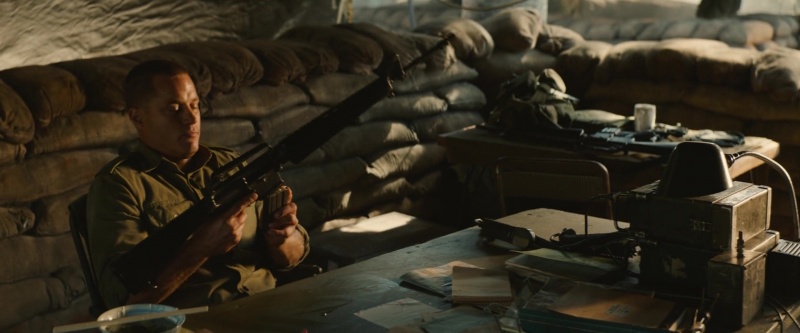
Maj Smith inspects Pve Large’s M16 after confronting him over his negligent discharge of the weapon while
covering the perimiter. Large comments on the rifle’s propensity to jam as well as its light weight compared to
the L1A1.

A soldier holds his L1A1 at the ready in case of an NVA attack while most of 1ATF’s forces leave to help
Delta Company. The length of the rifle (45in or 1,143mm) is on full display, not even fully fitting into frame.
Another noteworthy Australian weapon on display is the Owen submachine gun of WW2 vintage. Developed
by a young Australian man just before the war, this strange looking, seemingly upside down SMG was a favorite
of soldiers in the Pacific, proving to be simple, reliable, and effective, excelling in the sort of close range ambushes
typical of jungle fighting. Still issued to radio operators at the time of Long Tan, they saw extensive use in Vietnam
until they were slowly replaced by the M16.
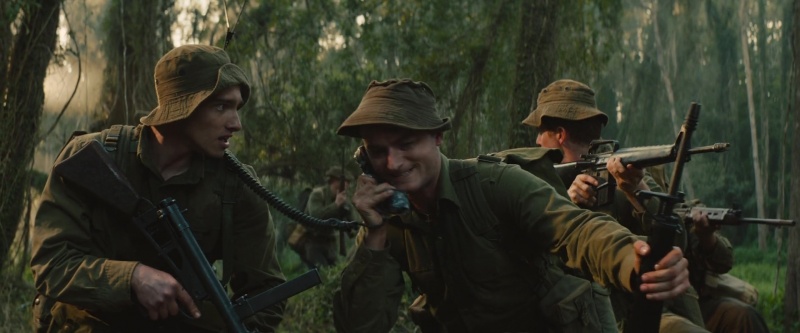
Pve Bartlett carries his Owen gun at the ready while 2LT Sabben uses the radio on his back. The Owen,
though slightly heavier than an M16, shot the weaker 9mm pistol cartridge, making it extremely controllable
in fully automatic fire.
Recognizing the need for a lightweight machine gun for a platoon level force, the Australian army also acquired
another American-made weapon, the M60. Developed to meet the needs of a general purpose machine gun that
could be carried by a single man, placed on a tripod for static use, as well as mounted on vehicles, the M60 was
just what the Aussies needed in Vietnam for their patrol focused infantry. With one man carrying the gun and an
assistant gunner standing by to carry more ammunition and help with any malfunctions, the M60 could be moved
wherever the section leader needed it. This is demonstrated in the movie with Sgt Bob Buick moving the machine
gunner often during 11 platoon’s initial contact with the enemy. Compared to an older design, like the water cooled,
tripod mounted only Vickers machine gun of WWI vintage, the M60 could be fired from the hip in emergency
situations. We see Pte Eglinton use this to full effect as he rakes the hut behind them with fire from his M60,
neutralizing the sniper that had snuck up on them. This sort of mobility was also found in the 7.62 L4 BREN gun
also then in service with Commonwealth forces, but the M60 had the advantage of being belt fed compared to the
30 round magazines of the BREN gun, allowing it to churn out a nearly continuous stream of firepower with less
time between reloads. At platoon level engagements like we see in the film, this sort of mobile firepower can be
the deciding factor between victory and defeat, a fact not lost on the commanding officers and NCOs who are
constantly pointing out and focusing fire on the enemy machine guns bearing down on them.

Pte Eglinton spins around and fires from the hip at the hut, killing the sniper by punching through the walls with
the powerful 7.62x51 round the M60 fires.
While the Australian forces are undoubtedly the focus of this film, the NVA and NLF (Vietcon) forces and their
equipment also feature heavily throughout. Mostly equipped by support from the Soviet Union, the NVA and NLF
carry a smorgasbord of rifles, machine guns, and support weapons into battle. While the AK-47 and its variants are
front and center, some other less known rifles like the SKS, STG-44, and M91/30 Mosin also see considerable use
during the conflict. The Soviets had vast stores of weapons from WWII like the Mosin rifle, PPSH submachine gun,
and Goryunov SG-43 machine gun that they gave to North Vietnam as aid, including captured German arms like
the MP-40 submachine gun, STG-44 assault rifle, and considerable amounts of the MG-34 machine gun. Quickly
replaced by the AK-47, the vast numbers of leftover semi automatic SKS carbines were another Soviet
and Chinese manufactured rifle that saw considerable use in the conflict. Northern forces would also issue
any weapons captured on the battlefield, as evidenced by a few M16s seen in the hands of NVA soldiers in the film.
Always short on weapons after having fought colonial powers since WW2, the NVA would take whatever they could
get their hands on in their fight for independence.

NVA soldiers fire their SKS (on the left, partially blocked by the tree) and STG-44 (in the center) rifles as they
close in on Delta company.
Initially held back as a last resort, the vehicles and artillery at 1ATF’s disposal would prove to be vital to the
survival of Delta company as they found themselves low on ammo, facing superior numbers. Alongside the
infantry battalions in Nui Dat were 1st APC Squadron and their M113 armored personnel carriers, 1st Field
Regiment, Australian Artillery and their 105mm L5 howitzers, 3rd SAS Squadron, and engineers, recon aircraft,
intelligence, logistics, and eight Huey helicopters from No. 9 Squadron RAAF. All of these components worked
together to support patrols as they worked to interdict Vietcong activity in the area.
1st APC Squadron is seen in the film coming to the rescue of Delta company, carrying Alpha company in
their M113s. Yet another American piece of equipment purchased by the Australians, the M113 was a brand
new armored personnel carrier that had been in development since the end of WW2. Carrying 11 soldiers in
the rear compartment and a driver and commander manning a .50 caliber machine gun, the M113 proved to
be a reliable workhorse in Vietnam and on into the present day. If you thought some of the commanders
looked vulnerable behind their machine guns up top, you’d be right. Almost as soon as they began to see
service in Vietnam, ad-hoc shields were added in the field to better protect the commander. In the battle of
Long Tan, only a few such shields had been fitted to the turrets of 1st APC’s vehicles, leading to casualties
as they entered the fight. Eventually, armored shielding around the turret was standardized as the ACAV
(Armored Cavalry Assault Vehicles) model of M113 with extensive armor around the .50 caliber machine
gun as well as two armored turrets for M60 machine guns on either side. Australian engineers would take
it even a step further by adding the 76mm gun turret of a Saladin armored car to create a fire support vehicle
out of the M113. The adaptability of the vehicle was put to good use with mortar carrier, command and
communication, flamethrower, cargo, and vehicle recovery variants developed alongside the main troop
carrying version. The cross country mobility of the M113 is on full display in the film as 1st APC charges
across roads and fields to relieve Delta. The speed and maneuverability of the M113 came in part from its
6-cylinder diesel engine as well as its relatively lightweight aluminum alloy armor. While this armor wasn’t as
effective as conventional steel armor, the trade off in speed and weight were essential to its success, allowing
the M113 to be air transported to whatever theater of operations it was needed much faster than a heavier
vehicle that relied on rail or shipping. Keep your eyes peeled for a Danger Close: Mechanized covering the
M113 in even more detail once the podcast is released!
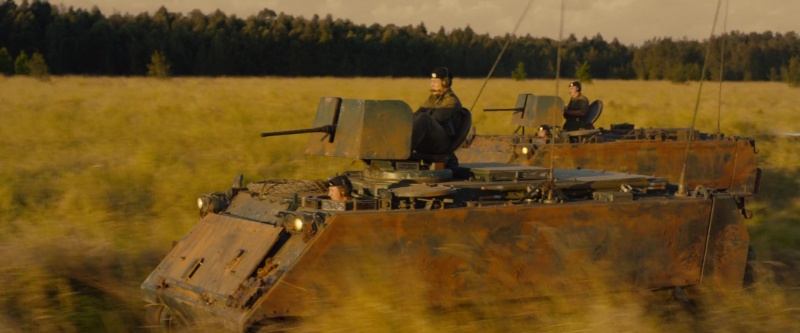
1st APC M113s race through a field to bring much needed fire support and reinforcements to Delta company.
Possibly the most important support element 1st ATF had at its disposal during the battle of Long Tan was the
1st Field Regiment, Australian Artillery and their Italian made 105mm L5 howitzers operated by the New
Zealanders of the 161st Battery, Royal New Zealand Artillery, then serving under the 1st ATF. Designed for
mountain troops by Italy, the OTO Melara Mod 56 was adopted by Commonwealth forces as the L5. Before
being replaced by larger, more permanent field guns, the 18 L5 guns at Nui Dat provided cover support at a
moment’s notice to soldiers on patrol around the base. Portable by nature, the L5 could even be moved outside
of the base to catch the enemy off guard outside of their normal, relatively short range firing from inside the wire.
In the battle of Long Tan, these guns were directed with brutal potency, saving the lives of the vastly outnumbered
infantry in the field. At the very beginning of the film, we see the base at Nui Dat under fire from enemy mortar and
recoilless rifle fire. After the positions are triangulated with compass bearings, a counter battery by the Kiwi’s L5
guns put a stop to the mortar fire. Bravo company is sent out on patrol to locate the mortar positions, being relieved by
Delta company who goes on to do most of the fighting later in the day. Thanks to the radio operators attached
to each platoon as well as their knowledge of the area, the Delta company NCOs and officers are able to call in
devastating artillery fire from the base only a few kilometers away. Sometimes landing nearly on top of the men
in the field, this artillery support was crucial in saving D company, and in particular 11 platoon, from being
overwhelmed by a force nearly one hundred times the size of their unit. The professionalism from the radio
operators and the artillery men on display in the movie was refreshing to see as it was this relationship that really
made the difference while the battle raged throughout the day. One small mistake on the part of the artillery
regiment could have resulted in a tragic fratricide incident, especially with how close they were firing to their
own men.
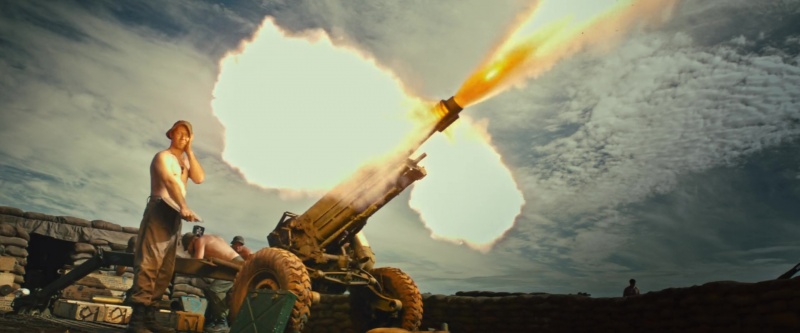
An L5 howitzer of the 161st Battery, Royal New Zealand Artillery fires on targets in support of Delta company.
The balls of fire blasting out the sides of the barrel are a result of the sizable muzzle brake fitted on the guns,
helping to redirect some of the recoil forces on the relatively lightweight gun.
Overall, I was incredibly impressed with this movie’s portrayal of the battle of Long Tan. Peter even commented
to me that it approaches a documentary in how well it follows real events. I can’t think of anything that came
across as an egregious mistake or bending of the truth. The timeline of events was spot on compared to
everything I found in my research and all the equipment was authentic. The movie almost did our job for us as
the story it presents is a fantastic retelling of the events of August 18th and 19th, 1966.
Below is a segment from an Australian 60 Minutes broadcast where two of the soldiers depicted in the film,
Sgt Bob Buick and 2LT Dave Sabben, return to the rubber tree plantation at Long Tan and meet up with two
NVA veterans. The personal accounts are harrowing and it was interesting to see what the actual area looked like.
